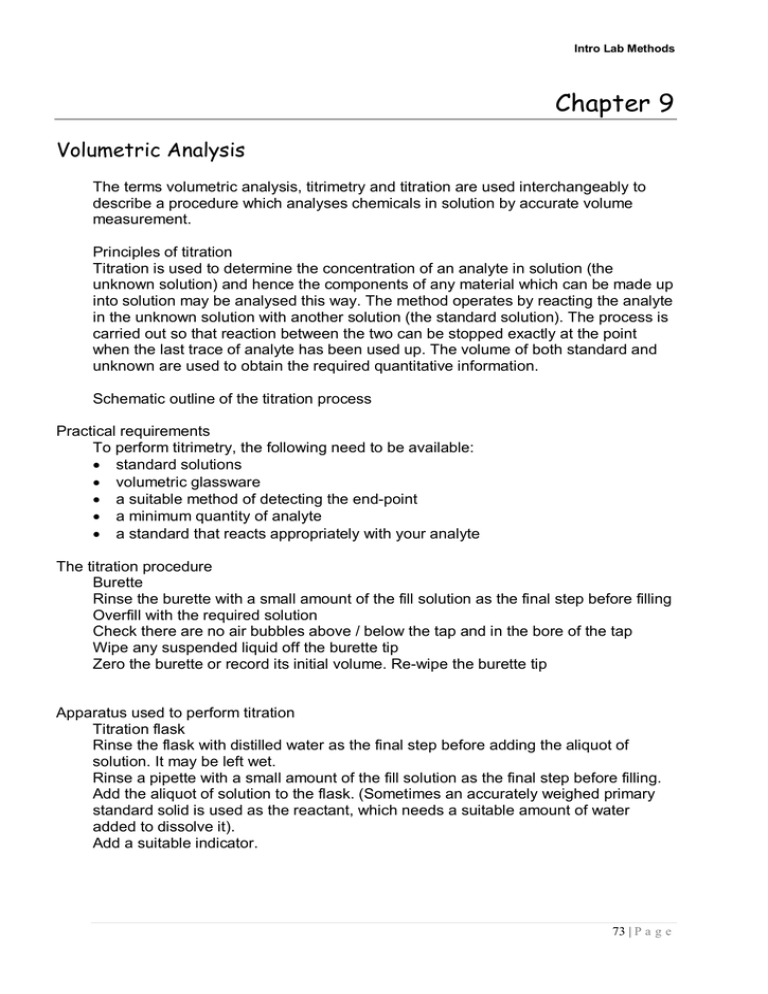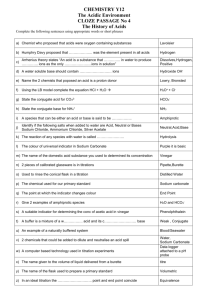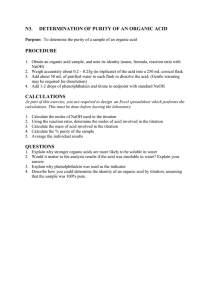Chapter 9 Volumetric Analysis
advertisement

Intro Lab Methods Chapter 9 Volumetric Analysis The terms volumetric analysis, titrimetry and titration are used interchangeably to describe a procedure which analyses chemicals in solution by accurate volume measurement. Principles of titration Titration is used to determine the concentration of an analyte in solution (the unknown solution) and hence the components of any material which can be made up into solution may be analysed this way. The method operates by reacting the analyte in the unknown solution with another solution (the standard solution). The process is carried out so that reaction between the two can be stopped exactly at the point when the last trace of analyte has been used up. The volume of both standard and unknown are used to obtain the required quantitative information. Schematic outline of the titration process Practical requirements To perform titrimetry, the following need to be available: • standard solutions • volumetric glassware • a suitable method of detecting the end-point • a minimum quantity of analyte • a standard that reacts appropriately with your analyte The titration procedure Burette Rinse the burette with a small amount of the fill solution as the final step before filling Overfill with the required solution Check there are no air bubbles above / below the tap and in the bore of the tap Wipe any suspended liquid off the burette tip Zero the burette or record its initial volume. Re-wipe the burette tip Apparatus used to perform titration Titration flask Rinse the flask with distilled water as the final step before adding the aliquot of solution. It may be left wet. Rinse a pipette with a small amount of the fill solution as the final step before filling. Add the aliquot of solution to the flask. (Sometimes an accurately weighed primary standard solid is used as the reactant, which needs a suitable amount of water added to dissolve it). Add a suitable indicator. 73 | P a g e Intro Lab Methods Rough titration Add the solution from the burette in a slow steady stream to the titration flask while swirling vigorously. Observe the colour of the indicator carefully for some change in its shade or hue. This is a sign of an approaching end-point Stop the addition when you see the sudden colour change. Record this volume reading which is a rough end point. Accurate titration Add the bulk of the rough titration volume (80-95%) rapidly, with swirling. Rinse the walls of the flask with distilled water to ensure all reactive species are in the mixing part of the flask Complete the addition drop-wise so that the end point is overshot by no more than one or two drops. Repeat the titration procedure with fresh materials until you have an acceptable set of end point volumes. Replicate determinations in an ideal analysis will all lie within 0.05 mL. The accumulated errors of the glassware used will produce a range of readings of at least this magnitude. All novices should aspire to performance which approaches these standards. 74 | P a g e Intro Lab Methods Practical work 9.1 Practice Titration Your teacher will demonstrate the practical technique of titration. The technique will be the same for the remaining practicals. It would be wise to spend a good deal of time practising before commencing on the remaining practicals. Procedure: 1. Obtain about 150 mL of the standard 0.1 M acid and unknown alkali solution in clean, dry labelled beakers. Cover the beakers with a watch-glass 2. Pour about 50 mL of distilled water into each of two 100 mL beakers 3. Add 5 mL of the acid to one beaker and 5 mL of the alkali to the other 4. Add sufficient screened methyl orange (SMO) to produce a colour. Note the colour of the solutions on your worksheet 5. Mix 10 mL of each of these solutions in a third beaker. Adjust the colour to the neutral colour by addition of small amounts of the acid or base as required. 6. Prepare a 50 mL burette with the standard acid as shown by the teacher 7. Fill and zero the burette with the acid solution 8. Pipette 25 mL of the unknown alkali into a 250 mL conical flask 9. Add the SMO and titrate as shown by the teacher to the neutral endpoint 10. Record your result 11. Repeat the analysis until you have three titrations within 0.1 mL Practical work 9.2 Standardisation of approx. 0.1M HCl 1. Pour about 400 mL of distilled water into a 600 mL beaker and carefully, with stirring, 2. Add the calculated amount of concentrated acid solution. Caution the acid is corrosive 3. Pour the solution into a clean, labelled 1 L storage bottle and make up to 1L 4. Mix well 5. Weigh accurately, in triplicate, about 0.15g of dried AR grade sodium carbonate (Na2CO3) into a weigh boat. Record the mass on the worksheet 6. Quantitatively transfer the weighed sodium carbonate into separate labelled conical flasks. 7. Add SMO to each flask 8. Prepare a burette with your acid solution 9. Titrate until the endpoint is reached. Record the titration value on the worksheet. 10. Repeat for each of the samples 11. Calculate the value of your acid solution and label your bottle 75 | P a g e Intro Lab Methods Practical work 9.3 Standardisation of approx 0.1 M NaOH 1. Weigh out about 4g of sodium hydroxide pellets on a top-pan balance and quickly transfer the pellets to 1L of polished water. Caution: the sodium hydroxide is caustic. Stir well 2. Transfer to a labelled storage bottle 3. Weigh out accurately, in triplicate, approximately 0.51g of potassium hydrogen phthalate (labelled KHP in the desiccators) using an analytical balance. Record the mass on the worksheet. 4. Quantitatively transfer the KHP to titration flasks 5. Prepare and fill a burette with the sodium hydroxide solution 6. Add phenolphthalein indicator (PP) and titrate to the baby pink end point. Record the titration value on the worksheet. 7. Repeat for each flask Cross-standardise your alkali solution with the acid solution you have previously standardised. 12. Pipette 25 mL aliquots of your HCl into conical flasks 13. Add two drops of phenolphthalein indicator and titrate with the NaOH until the pink just appears. 14. Record the value on your worksheet and repeat until you have three titrations within 0.1 mL. Practical work 9.4 Ethanoic acid content of vinegar 1. Pipette 25 mL of the concentrated vinegar into a 250mL volumetric flask and make up to the mark with polished water. Shake well. Label 2. Pipette 25 mL aliquots of the diluted vinegar into titration flasks 3. Titrate the vinegar with standard NaOH, using phenolphthalein indicator 4. Repeat until you have three good titration values Practical work 9.5 Sodium carbonate content of washing soda 1. Accurately weigh about 3.6g of washing soda crystals into a 150 mL beaker 2. Quantitatively transfer to a labelled 250 mL volumetric flask, dilute to the mark and shake well 3. Titrate 25 mL aliquots of the dilute washing soda with standard acid solution using screened methyl orange indicator. 4. Repeat until you have three good titration values. Practical work 9.6 Acid content of commercial fruit juice 1. Prepare and fill a burette with standard 0.1M NaOH. 2. Pipette 25 mL of apple juice into a titration flask and dilute with approx. 75 mL water. 3. Using phenolphthalein indicator, titrate until the first permanent pink appearance. 4. Repeat until you have three good titration values. 76 | P a g e Intro Lab Methods Student Name: Practical: Practice titration Practical Number: 9.1 Date Performed: Text book References Date Submitted: Results: 1. Observation of endpoint colour Colour of solution using screened M.O. Colour of solution using phenolphthalein Colour of solution Using M.O. Acid HCI Base NaOH End point 2. Practice Titration Concentration of supplied acid Volume of alkali pipetted into titration flask Volume of acid needed for titration end point 1 2 3 4 Average volume acid used for end point 3. Calculation of concentration of supplied alkali Concentration alkali = [Concentration acid x Volume acid] / Volume base = Questions: 1. What are the possible sources of error in the use of a burette? 2. Why should all readings be written down and checked before draining or refilling burettes? 3. Place each of the following pieces of glassware which may be used in a titration in the appropriate preparation column. Pipettes, burettes, volumetric flasks, titration conical flasks, beakers and bottles used to hold standard and other solutions. Glassware Used dry rinsed with solution to be placed in it rinsed with distilled water. Student Name: 77 | P a g e Intro Lab Methods Practical: Preparation & Standardisation of your own prepared approximately 0.1M Hydrochloric acid Practical Number: 9.2 Date Performed: Text book References Date Submitted: Procedure: Using the following formula C1V1 = C2V2 calculate the volume of 11.6 M HCl required to prepare 1 Litre if 0.1M HCl. (10mL) Show your working in this space: Results Standardising your prepared hydrochloric acid using sodium carbonate primary standard HCl vs Na2CO3 1 a Mass Na2CO3 (g) b Moles of carbonate (a ÷ 106) c End point Volume (mL) d Volume in L (c ÷ 1000) e Moles of your acid (b x 2) Concentration of your acid (e ÷ d) 2 3 4 Average value for molarity of your prepared HCl is Questions: 1. Explain what is meant by the term quantitative transfer. 2. Why is the sodium carbonate kept in a desiccator? 78 | P a g e Intro Lab Methods Student Name: Practical: Preparation & Standardisation of your own ≈ 0.1M NaOH Practical Number: 9.3 Date Performed: Date Submitted: Text book References Procedure: Using the following formulas to calculate the mass of NaOH (FW = 40) required to prepare 1 Litre if 0.1M NaOH. (4g) [mass = FW x No. of moles] & [no. of moles = volume (L) x molarity] Show your working in this space: Results: (a) Standardising your prepared sodium hydroxide using potassium hydrogen phthalate (KHP) primary standard 1 a Mass KHP (g) b Moles of KHP 2 3 4 (a ÷ 204) c End point Volume (mL) d Volume in L (c ÷ 1000) e Moles of your alkali (b x 1) Concentration of your alkali (e ÷ d) Average value for the molarity of your NaOH is (a) Cross check your NaOH by titration against your standardised HCl. This will give you a second answer for NaOH concentration C2 V2 V1 C1 = = = = concentration of your HCl from last job Volumes of HCl used at each end point Volumes of NaOH used at each end point Concentration of sodium hydroxide = = = = Average value for the molarity of your NaOH is Questions: 1. How well do the two answers for your prepared sodium hydroxide compare? 2. Why was the NaOH not weighed on an analytical balance? 3. Why are alkaline solutions stored in plastic rather than in glass? 79 | P a g e Intro Lab Methods Student Name: Practical: Ethanoic acid content of Vinegar Practical Number: 9.4 Date Performed: Date Submitted: Text book References Procedure: Results: Volume of original vinegar taken = Volume of diluted vinegar = Vol. of diluted vinegar titrated = Concentration of NaOH used = Titration volumes (mL) Average titration value = Calculations: moles of NaOH used = = Concentration NaOH x Average titration / 1000 moles ethanoic acid = = moles of NaOH Concn ethanoic acid (diluted) = = moles ethanoic acid / (volume of aliquot/1000) Concn original ethanoic acid = = Concn of diluted vinegar x 10 Mass ethanoic acid per L = = concentration ethanoic acid x 60 Mass ethanoic acid per 100mL or % (w / v) = = Mass ethanoic acid per L ÷ 10 Percentage of ethanoic acid in vinegar is % (w/v) Questions: 1. How would you titrate if brown vinegar had been used in place of white vinegar? 2. How does your answer for the vinegar compared to food authority standards for legal vinegar? 80 | P a g e Intro Lab Methods Student Name: Practical: Sodium Carbonate Content of Washing Soda Practical Number: 9.5 Date Performed: Date Submitted: Text book References Results: Mass of washing soda: = Size of volumetric flask: = Aliquot volume = Concentration of HCl = Titration volumes Average titration value = Calculations: moles of HC1 = concn of HCl x average titration volume / 1000 moles sodium carbonate (in diluted aliquot) = moles of HCl / 2 molarity of sodium carbonate (in analytical solution) = moles in diluted aliquot ÷ volume of diluted aliquot (L) mass of sodium carbonate in 250mL = FW x molarity sodium carbonate x 0.25 % sodium carbonate = mass sodium carbonate X 100 mass washing soda used Average value for sodium carbonate content of washing soda is % (w/w) 81 | P a g e Intro Lab Methods Student Name: Practical: Acid content of Commercial Fruit Juice Practical Number: 9.6 Date Performed: Date Submitted: Text book References Results: Concentration of NaOH: = Volume of juice taken = Titration volumes Average titration value = Calculations: moles of NaOH = Concentration NaOH x titration / 1000 moles of malic acid in aliquot of juice = moles NaOH / 2 (only applies to apple juice) mass of acid in 25 mL = moles acid x 134 (only applies to apple juice) = Mass of acid in 100 mL = % (w/v) Percentage of malic acid in apple juice is Questions: If you were analysing blackcurrant juice would the endpoint be easy to observe? How could you solve this problem? 82 | P a g e Intro Lab Methods CALCULATION OF TITRATION RESULTS The double outline box shows your answer all in one go. The boxes underneath do the calculations step-wise. TASK 1 STANDARDISE 0.1M HCl Formulae to Your results use Concentration of unknown HCl solution = 2 x (mass of Na2CO3 ÷ 106) ÷ (volume of HCl (mL) ÷ 1000) Moles of carbonate = mass of Na2CO3 ÷ 106 Moles of acid = moles of carbonate x 2 Molarity of acid = moles of acid ÷ (end point volume (mL) ÷ 1000) TASK 2 STANDARDISE 0.1M NaOH Formulae to use Concentration of unknown NaOH solution = volume of HCl (mL) x concentration of HCl ÷ volume of NaOH (mL) at end point Your results moles of HCl = volume of HCl (mL) x concentration of HCl from task 1 moles of alkali = moles of HCl ÷ (end point volume ÷ 1000) Molarity of NaOH = moles of alkali ÷ end point volume ÷ 1000 83 | P a g e Intro Lab Methods Conversion of mass of water to volume of water via its density at different temperatures temperature 0 1 2 3 4 5 6 7 8 9 10 11 12 13 14 15 16 17 18 19 20 density temperature 999.8395 999.8985 21 999.9399 22 999.9642 23 999.9720 24 999.9638 25 999.9402 26 999.9015 27 999.8482 28 999.7808 29 999.6996 30 999.6051 31 999.4974 32 999.3771 33 999.2444 34 999.0996 35 998.9430 36 998.7749 37 998.5956 38 998.4052 39 998.2041 40 density 997.9925 997.7705 997.5385 997.2965 997.0449 996.7837 996.5132 996.2335 995.9448 995.6473 995.3410 995.0262 994.7030 994.3715 994.0319 993.6842 993.3287 992.9653 992.5943 992.2158 Steps for calculating your true volume 1. Select the temperature which most closely matches your water's temperature 2. Find the density value in the table which corresponds to this temperature 3. For each of your measured masses of water, enter the numerical value for mass into your calculator 4. divide this value by the density figure from the table 5. multiply by 1000 (to compensate for density being shown as kg / m3) 6. your display will now show your true volume for that mass of water. 7. Enter this value into you manual result sheet. 84 | P a g e




